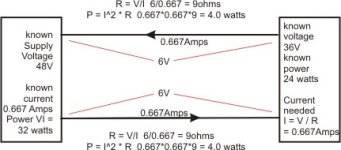Alan Case
Lifetime Supporting Member
Hi.
I know this should be simple and I should know it but I can't seem to get the grasp of the matter.
I have a 48V DC power supply that is feeding a DC to DC converter.
The converter has a 36-72V input and always an output of 24V DC.
Connected to the output side of the DC converter is a resistive load of 24 watts. Therefore the current flowing in the output circuit is 1 amp at 24V.
By calculation and assuming the DC converter is 100% efficient then there should be 0.5 amps at 48V flowing in the input side.
Now if we place the 48V power supply at a distance from the DC to DC converter and connect them together with thin wire so that there is a considerable voltage drop in the system.
Lets assume the voltage at the input side of the DC to DC converter is now 36V.
The power in the cable feeding the DC to DC converter should still be 24 watts.
Now to calculate the current in the cable do we use the voltage accross the input terminals of the DC to DC converter (36V 0.75A) or the voltage of the supply (48V 0.5A)
Common sense tells me to use the 48V figure and ignore any voltage drop in the circuit. The above layout is a small part of a larger system where there are multiple DC-DC converters connected to a main power bus. I am trying to calc the voltage available at each point on the network by working backwards from the wattage.
I hope I have explained this well enough.
Thanks in advance
Alan Case
I know this should be simple and I should know it but I can't seem to get the grasp of the matter.
I have a 48V DC power supply that is feeding a DC to DC converter.
The converter has a 36-72V input and always an output of 24V DC.
Connected to the output side of the DC converter is a resistive load of 24 watts. Therefore the current flowing in the output circuit is 1 amp at 24V.
By calculation and assuming the DC converter is 100% efficient then there should be 0.5 amps at 48V flowing in the input side.
Now if we place the 48V power supply at a distance from the DC to DC converter and connect them together with thin wire so that there is a considerable voltage drop in the system.
Lets assume the voltage at the input side of the DC to DC converter is now 36V.
The power in the cable feeding the DC to DC converter should still be 24 watts.
Now to calculate the current in the cable do we use the voltage accross the input terminals of the DC to DC converter (36V 0.75A) or the voltage of the supply (48V 0.5A)
Common sense tells me to use the 48V figure and ignore any voltage drop in the circuit. The above layout is a small part of a larger system where there are multiple DC-DC converters connected to a main power bus. I am trying to calc the voltage available at each point on the network by working backwards from the wattage.
I hope I have explained this well enough.
Thanks in advance
Alan Case





